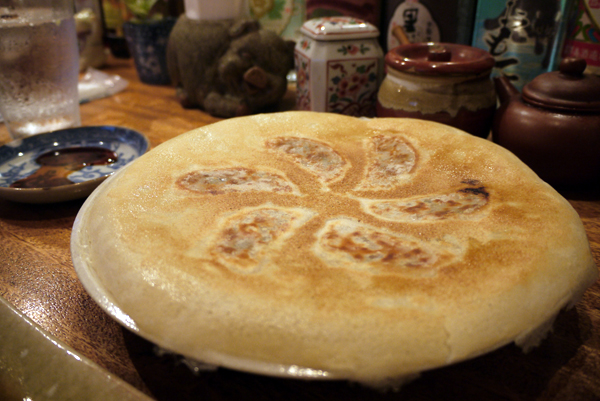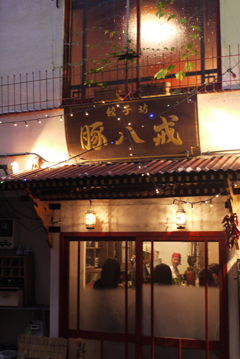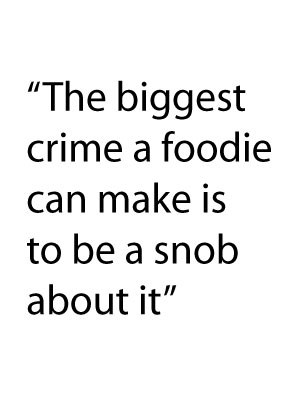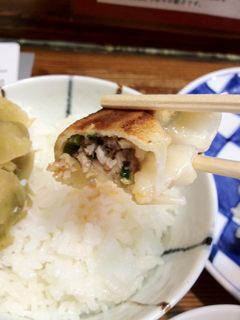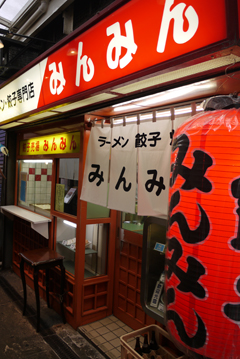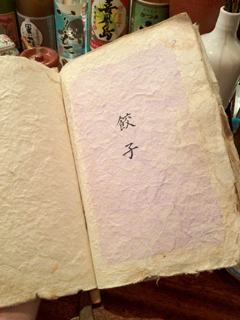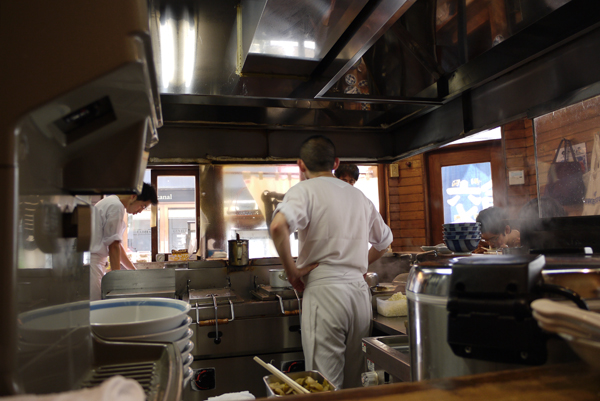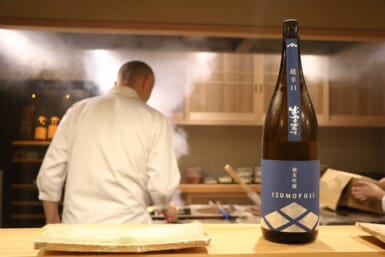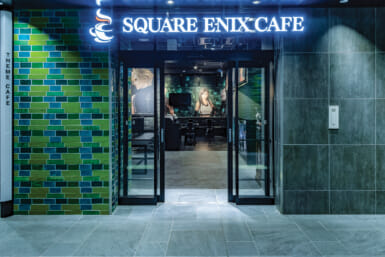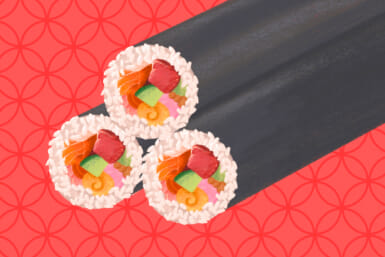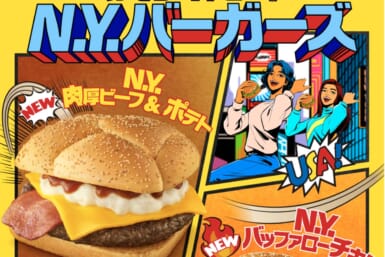Rain trickled over the clear plastic surface of my battered, misshapen convenience store umbrella, forming miniature pools for a split second before running off in the direction of the one broken metal arm and pattering down onto my left shoulder, its dripping sound like a ripple of sarcastic applause.
“Well done, son; you’re here. Again.” Clap clap clap. “Third time lucky?”
Somewhere in amongst the maze of narrow, neon and paper lamp-lit backstreets, a Japanese businessman warbled a classic oldie in a snack or karaoke bar. Trains rumbled into the station just a row of buildings behind me and muffled announcements about doors closing were followed by sudden bursts of leather-soled footsteps shuffling about their business.
My empty stomach murmured in quiet protest and I peered, for the nth time, inside Cho Hakkai (豚八戒) to see if anyone was showing signs of leaving, or whether a seat might open up. I was here for one thing: the mythical, mouth-watering golden dumplings of pure sunshine that had, just a week earlier, simply been “pretty good gyoza” according to abundant internet chatter I’d been following.
I had come to Asagaya – just eight minutes from Shinjuku on the JR Chuo line – no fewer than three times in pursuit of these gyoza. Each time, for one reason or another, I had been denied. And with each denial those little fried/steamed/boiled dumplings had shot up a rank in my estimations, to the point that they were fast becoming the stuff of legend. This had become a full-on Gyoza Hunt. With Capital Letters.
Today, nothing — not the rain, my trashed umbrella, nor the crowd of seemingly insatiable customers who had already claimed every seat in the house – nothing was going to deter me; I would wait as long as it took for those dumplings.
During my many attempts to procure some of Cho Hakkai’s gyoza, I learned the hard way a number of useful facts:
1. They are closed on Mondays. This is a rookie mistake for any gyoza hunter to make, as a quick internet search will clearly show when their scheduled holidays are (Mondays!!). But even so, there are few sights more pathetic than a near-salivating man excitedly arriving at his desired dining destination only to be met by nothing but a dark, shuttered shop-front.
2. The place fills up. Fast. My second attempt at dining at Cho Hakkai ended better than my first but, arriving a mere three minutes after the place had opened and finding every seat in the house already occupied, I fell at the last hurdle.
3. They take reservations, but only for their opening time of 6pm, so you either book in advance, get lucky, or wait for your seat. And if you’re like me and really unlucky, turning up early doesn’t necessarily guarantee you seat either.
But, as someone, somewhere, once possibly muttered: “with rejection comes opportunity.” I’d told my stomach that it’d be getting gyoza and, despite being denied the prize at Cho Hakkai, nothing else would fill that void in my gut. After both of my failed visits, I found myself impatiently punching ‘gyoza’ into Google maps and looking for alternative location where I could satisfy my craving. It was on one such rebound hunt that I learned another important lesson: The biggest crime a foodie can make is being a snob about it.
On my many gyoza hunts – starting some time back in 2010 when I first visited G-Bros, a gyoza-centred izakaya in Hitachi city, I’d done my best to track down places that depend almost entirely on their gyoza to make a living; to my mind, if the gyoza only appeared on the side menu, they weren’t up to scratch. This turned out to be another rookie mistake and I dread to think how many incredible gyoza I’ve missed out on since back then.
I’d always done my best to track down places that depend almost entirely on their gyoza to make a living; to my mind, if the gyoza only appeared on the side menu, they weren’t up to scratch. This turned out to be another rookie mistake, as I was to discovered when my smartphone led me to Kichijōji’s Harmonica Yokochō, a narrow labyrinth of food, coffee and beer stands brimming with rough edges and diamond finds. I was searching for Min-Min (みんみん), a place well known locally for its gyoza but, it turns out, predominantly a ramen restaurant.
Google maps had guided me so far, but no amount of satellites, maps or waves of invisible magic was going to help me now that I was this far into the rabbit-hole. Search as I might, I somehow kept winding up on the same corner outside a yakitori stand where each time the owner shot me curious glance after concerned stare.
I turned back in the direction I had come from, cursing my terrible sense of direction and starting to feel the kind of irritation that only an empty stomach can bring, when, adjusting my bag on my shoulder, my faithful old umbrella suddenly burst open. The spindly metal arms shot out in all directions like spines on some kind of mad shuriken-equipped puffer-fish, the tip of one narrowly missing a young woman’s face. Droplets of lukewarm rainwater noisily peppered everything within a three foot radius.
I apologised profusely, struggling to divide my attention between controlling my demonic umbrella and forming coherent sentences in Japanese. The young woman, understandably quite annoyed, produced a handkerchief from her bag and dabbed her face with it before forcing a tiny smile of exoneration in my direction and turning away. She was not two yards from me when I noticed the plastic bag she was carrying; inside sat two packs of hot, yellow-gold gyoza.
Quite forgetting myself, I immediately called after the woman, who looked back with an expression not too far removed from one of panic, presumably concerned that I was about to finish the job and lunge wildly at her throat with the tip of my umbrella. In my politest Japanese I ventured, “I don’t suppose,” I pointed at her bag, “those are from Min-Min?’
Her face lit up.
Let it be known, ladies and gents, that the love of food, like literature, film and music, can bring any two people – shy middle-school kids; warring maniacal dictators; umbrella-wielding assailants and busy shoppers – together in mutual understanding and friendship. Moments later, my new friend and I were chatting happily about our mutual love of food and its ability to cure all ailments, and I learned that she stopped by Min-Min once a week, without fail, to buy gyoza as a treat for her family.
The young woman directed me to the restaurant and waved goodbye, punctuating her parting words with enthusiastic nods. “I’ve never had their ramen,” she said, “but the gyoza are great.’ She wasn’t wrong.
Min-Min only seats around 12 people and has a simple, no-frills layout – a couple of tables, a long, plain counter with stools and a narrow kitchen separated from the dining area by a row of long glass panels. It’s not the kind of place to sit and while the night away with friends but it is somewhere to start your evening, make no mistake.
On the evening of my visit, the place was close to full capacity and, although I saw several people happily tucking into bowls of steaming hot ramen, nearly everyone had a small plate of gyoza in front of them. The gyoza themselves – of the fried variety, costing 400 yen for five – aren’t too heavy on the garlic like some ramen places’ efforts, and they’re big enough to require a couple of substantial bites to consume. The fillings are soft and juicy, while the skins are thick enough to require a satisfying amount of chewing, and also soak up a soy sauce/vinegar/chilli oil combination nicely.
By the end of my meal I was a changed man. As I dabbed my sheepishly-smiling face, I got back on my phone and started searching for more hunting grounds. Kichijōji, I soon discovered, has plenty of gyoza to go around.
One of the best places I found was Ichi En (一圓), a ramen shop on Nakamichi-dori (left out of JR Kichijōji Station’s north exit, then straight for a couple of hundred metres). It offers up both jumbo gyoza at 450 yen for five and small, bite-sized gyoza going by the somewhat grandiose moniker ‘Platinum Gyoza’ that cost 600 yen for five; a price that did nothing if not arouse my curiosity. Six slightly pricey golden dumplings later, I was genuinely impressed. I don’t know whether they’re using pork from specially bred, hourly-massaged, bed-time-story-read-to, pep-talked pigs or whether there’s some other secret process involved, but Ichi En’s gyoza are worth every single yen.
It’s little wonder that there is sometimes up to a twenty minute wait for gyoza at Ichi-en customers routinely wait on the wooden bench outside, even on swelteringly hot sunny days like the one on which I visited.
The day of my third visit to Cho Hakkai, lest we forget where this story began, however, was not so warm. Japan’s unpredictable rainy season was well upon us and the rain poured from the sky. I stood, hungry yet determined, under my decrepit umbrella, waiting for my seat. This was it; over the top; the last hurrah. An hour later, there was a gap in the crowds. My seat opened up. I was in.
With just seven stools at the edge of a simple, wooden-topped counter, Cho Hakkai could be described as a little on the cramped side, but its welcoming, relaxed atmosphere effortlessly converts that to ‘cosy’ in no time at all.
The menus are printed on thick, soft washi-style paper that makes you feel like you’re reading ancient parchment and are about to be cooked for by an enlightened Buddhist monk, but this feeling is soon offset by, along with the proprietor’s stylish flat cap and jazz-club style beard, a single can of Campbell’s tomato soup with its now iconic design sitting boldly on a shelf at the back of the counter. Whether this is a cheeky nod to Warhol or part of some secret ingredient I have no idea, but the quirk and charm of Cho Hakkai’s atmosphere took my mind off my increasingly complaining stomach while I waited for the food to arrive.
And arrive it did. A golden circle of hane-tsuki gyoza (羽根付餃子) – a pan of gyoza with a wafer-thin layer of crispy dough across the top, connecting them all together until you dive in with your chopsticks and wreak mayhem – soon arrived in front of me. The restaurant owner pointed me in the direction of the usual soy sauce and chilli-oil pots, but I tackled them au-naturale and polished the entire plate off in less than five minutes.
So, the burning question: Did Cho Hakkai’s gyoza live up to my lofty expectations? Absolutely. Are they easy to describe with mere words? Not at all. Possibly thanks to the restaurant’s partly Chinese ownership, Cho Hakkai’s gyoza – especially the fried kind – are unique to say the least.
Usually when I eat gyoza, I find myself weighing up the amount of garlic or Chinese chives in the mix, or examining the proportions of meat and cabbage a chef uses.
With these gyoza, though, it was a different story. With each careful bite I mulled the same question over and over in my mind: “what is that spice in there?” But I couldn’t put my finger on it.
With every discreet sniff or peer over the counter to see the chef effortlessly rolling a fresh batch, I got no closer to the answer. In the end, I resolved to take my newly learned gyoza-hunting lessons to heart; I stopped trying to be a critic and started tucking in.
Before I left the restaurant, I managed to get through two servings of hane-tsuki gyoza, a plate of steamed gyoza, a portion of spicy Sichuan gyoza and a Chinese chicken breast with a rich, sticky sauce. And a beer. I felt that I deserved a beer.
Happy gyoza hunting, everyone! If you would like to find the shops mentioned in the piece, the addresses follow. Doesn’t that spoil the fun, though?
Cho Hakkai: Nearest station, Asagaya. Suginami-ku, Asagaya Minami 3-37-5
Ichi-En: Nearest station, Kichijoji. Musashino-shi, Kichijoji Honmachi 2-17-2
Minmin: Nearest station, Kichijoji. Musashino-shi, Kichijoji Honmachi 1-1-9
Words and photos by Philip Kendall

